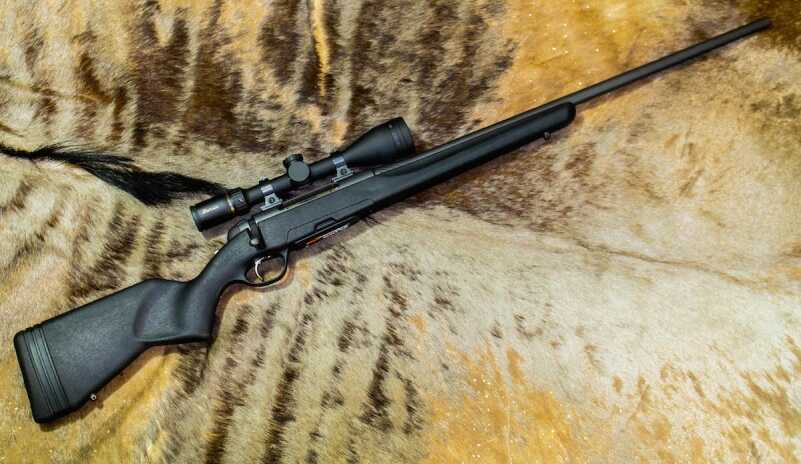
The Pro Hunter from Steyr is a great deal at $850 MSRP, featuring a hammer-forged barrel and rugged strength.
For more information, visit https://steyrarms.com/firearms/hunting-rifles/mannlicher-pro-hunter.html.
To purchase on GunsAmerica.com, click this link: https://www.gunsamerica.com/Search.aspx?T=Steyr%20Pro%20Hunter.

The test rifle was equipped with a Burris Droptine 4.5-14X scope and was chambered for .300 Win. Mag.
The Steyr firm can trace its roots back to the mid-1860s, in Steyr, Austria, and they’ve always prided themselves on producing rifles that have been on the cutting edge of technology. Their Pro Hunter is no exception, being a reliable, if futuristic-looking, bolt-action repeater that is designed to take the worst the elements can throw at it. With its cold hammer-forged barrel, synthetic stock – with adjustable length of pull – and proprietary safety design, the Pro Hunter is nothing short of a tool created for use in any climate its owner is willing to endure, and handle the job well. It embraces modern technological advances fully; no iron sights for this rifle, it knows it’s been bred to be mated to a riflescope. With a Mannox finish – a proprietary coating which makes the steel nearly impervious to rust – the rains of the Northwest spruce jungles or snows of the Adirondack forests pose no threat to the Pro Hunter, and that synthetic stock ensures there will be no swelling of the barrel channel, affecting the point of impact of your rifle.
SPECS:
- Chambering: .300 Winchester Magnum (tested)
- Barrel: 25.6 inches cold hammer forged steel
- OA Length: 46¾ inches
- Stock: Black synthetic
- Sights: None furnished (drilled and tapped for scope mounts)
- Action: Bolt-action repeating
- Finish: Anti-corrosion Mannox finish
- Capacity: 3+1 (as tested), detachable polymer magazine
- MSRP: $850.00
The test model I received was chambered in .300 Winchester Magnum; a perfect “do-all” caliber for a rifle of these capabilities, and a cartridge I’d comfortably take into all hunting situations save the truly huge and dangerous game. The Pro Hunter in .300 Winnie would be perfect as a moose or elk rifle, a bear gun, an antelope/deer/sheep rifle and also an African plains game rifle. The 25½-inch barrel length of the Steyr Pro Hunter will take full advantage of the capabilities of the .300 Winchester Magnum, and while it is longer than many of our standard big game rifles, the Pro Hunter still carried and balanced well. I actually prefer this length of barrel for this cartridge, as it allows all the powder to be used and generates a bit more muzzle velocity.
My test rifle was mated to a nice Burris Droptine 4.5-14×42 riflescope with an adjustable objective, set in Talley rings and bases. This level of magnification would best serve a flat-shooting cartridge like the .300 Winchester, and the excellent Talley mounting system guarantees that things absolutely will not move. The Burris Droptine I used featured the Ballistic Plex reticle, a simple system which makes shots at longer, yet sane, distances easier to make confidently. It is an effective, yet uncluttered reticle, which I have found to be extremely useable.
Some Unique Features
The Pro Hunter is well thought out, and has a few, very interesting features that should be pointed out. These features set the Pro Hunter apart from the rest of the huge field of bolt-action rifles; Steyr is once again pushing the envelope. I immediately noticed the three-position rotary safety, located on the tang, for a natural, easy-to-use feel. In the fire position, a red dot is revealed at the rear base of the wheel, in the middle position – where the sear is blocked and the bolt free to load and unload the rifle – a white dot is evident at the front end of the wheel. In the full rearward position, the bolt is blocked, as is the sear, and a spring-loaded tab is raised, which needs to be consciously pushed down in order to rotate the safety to bring the rifle into the middle (or fire) position. The Pro Hunter has an additional safety feature, which is rather revolutionary. Imagine you are beginning your hunt, cartridge loaded in the chamber, rifle on safety, hiking in with some buddies. With the gun in the full-safe position (bolt and trigger blocked), you can push down on the bolt until you hear an audible click. This position will completely lock the firing pin, until you push the tab and rotate the safety. Personally, I like any and all extra measures of safety. All in all, the safety design makes good sense, is located in a logical position, and the shooter can quickly adapt to it.
[one_half]
[/one_half]
[one_half_last]

Pro Hunter in the middle position – indicated by the white dot – blocking the trigger but allowing the bolt to be operated.
[/one_half_last]

Pro Hunter in “full safe” position – note the raised tab – preventing the bolt from moving and still blocking the trigger.
To remove the bolt, raise the bolt handle, rotate the safety to the locked position – with the tab raised up – and depress the trigger while you pull the bolt out rearward.
The barrel of the Pro Hunter has a unique look – Steyr refers to the look as “swirly” – from the cold hammer forging process. It reminds me of wrought iron; twisted and attractive. It uses a traditional hunting crown, and the sightless barrel is of medium contour.
The trigger of the Pro Hunter breaks crisp, even if it does have a bit of creep. Measuring the weight with my Lyman digital trigger scale, the average of five pulls measured 2 pounds, 9 ounces. Steyr’s polymer, detachable magazine loads into the underside of the receiver in two stages. The first stage holds the magazine firmly, but a bit lower, so as not to allow the bolt face to push a cartridge into the chamber, to allow for single feeding. Pushing it up a bit more allows the normal use of the magazine.
The Pro Hunter’s stock uses a rather long forend, which would be perfect with a bipod, although there is only one sling stud on the forward end instead of two. While the stock may not be the most attractive design I’ve ever seen, it certainly feels good in the hands; the texture is rough enough to afford a firm grip in all temperatures. The trigger guard is part of the molded stock, so the entire affair is one homogenous piece.
The receiver is closed, with the exception of the ejection port, and the Pro Hunter’s bolt uses four locking lugs to keep things neatly closed up. The bolt handle is fashioned in the butterknife design, yet bent to accommodate a low mounted scope. Steyr uses a push-feed system, with a plunger ejector located on the bolt face. I had no issues with either feeding or ejection during the course of testing.
At the Shooting Bench
The late winter/early spring in Upstate New York was not a shooter’s best friend. A couple feet of late snow, followed by the annual spring rains that make outdoor activities difficult, if not impossible, prevented me from getting to the shooting range. The gun was set up – the Burris Dropzone was properly mounted in Talley rings and bore sighted – and the test ammunition was procured, but I had to wait to shoot it. When the weather cleared and we had a nice Sunday afternoon, the Steyr got first priority. There’s something about Talley rings and bases that I had suspected from the first time I’d used them, but has been proven over time: They require the least amount of adjustment, once mounted, of any brand I’ve used. That theory proved itself again with this rig; it literally took two shots to zero the rifle. The Burris took adjustment like a pro, and I found that in spite of the heat waves of the spring day, it gave a clear, crisp sight picture.
I brought out a decent array of hunting and target ammunition for testing, to get an idea of what the Pro Hunter is capable of. Among the mix were a couple of loads from ABM Ammunition, featuring Berger target and hunting bullets at 168 and 185 grains, respectively, Federal Premium’s excellent 180-grain Trophy Copper Tipped, and Browning’s 155-grain BXR and 185-grain BXC. As you can see in the chart, this rifle, like many .300 Winchesters I’ve owned or loaded for, showed a definite preference for the heavier bullets with longer bearing surface. That’s not necessarily a bad thing, as it is these bullets that mate up very well with the case capacity of the .300 Winchester Magnum, and these bullets that will best retain their energy downrange and resist the effects of wind deflection.
[one_half]
[/one_half]
[one_half_last]

Federal Premium’s 180-grain Trophy Copper load shot very well from the Steyr Pro Hunter, and would be the author’s choice for a hunting round.
[/one_half_last]
Berger’s 185-grain Match Juggernaut OTM load from Applied Ballistic Munitions showed the best accuracy of the lot, and that’s no big surprise. Their reputation for consistency and concentricity is among the best, and I’ve yet to have a bad experience when punching paper or steel with a Berger bullet. They were among the first loads I tested, when the barrel was no more than simply cleaned of the rust-preventative that is was shipped with. I held the groups to three shots per load, as barrel heat in the .300 Winchester can become quite an issue. The Berger Juggernaut printed sub-MOA groups right out of the gate, with the three-shot group size averaging 0.8 inch. Were I looking for a good long-range target load for this rifle, I’d probably look long and hard to beat the characteristics of this bullet without handloading my cartridges. With a G1 Ballistic Coefficient of 0.552, and a muzzle velocity of almost 3,100 fps, this would make a good 1,000-yard load.
 Federal’s Trophy Copper hung nearly as tight, giving a consistent series of one-inch groups. For a hunting load, the monometal construction of the Trophy Copper 180-grain bullet is perfect, handling not only the potential for the high impact velocities of the .300 Winchester, but also reliably penetrate the vital organs lying behind the larger shoulder bones of species like bear, elk and moose. The Steyr Pro Hunter seemed to enjoy the Trophy Copper load immensely, and for an all-around choice for hunting near and far, in any sort of weather, this rifle/ammo combo will most certainly get the job done.
Federal’s Trophy Copper hung nearly as tight, giving a consistent series of one-inch groups. For a hunting load, the monometal construction of the Trophy Copper 180-grain bullet is perfect, handling not only the potential for the high impact velocities of the .300 Winchester, but also reliably penetrate the vital organs lying behind the larger shoulder bones of species like bear, elk and moose. The Steyr Pro Hunter seemed to enjoy the Trophy Copper load immensely, and for an all-around choice for hunting near and far, in any sort of weather, this rifle/ammo combo will most certainly get the job done.
Recoil with both of these loads was more than manageable, due to the recoil pad and stock design of the Pro Hunter. Some .300 Winchesters can be a bit of a bugger off the bench, but that was not the case with the Pro Hunter.
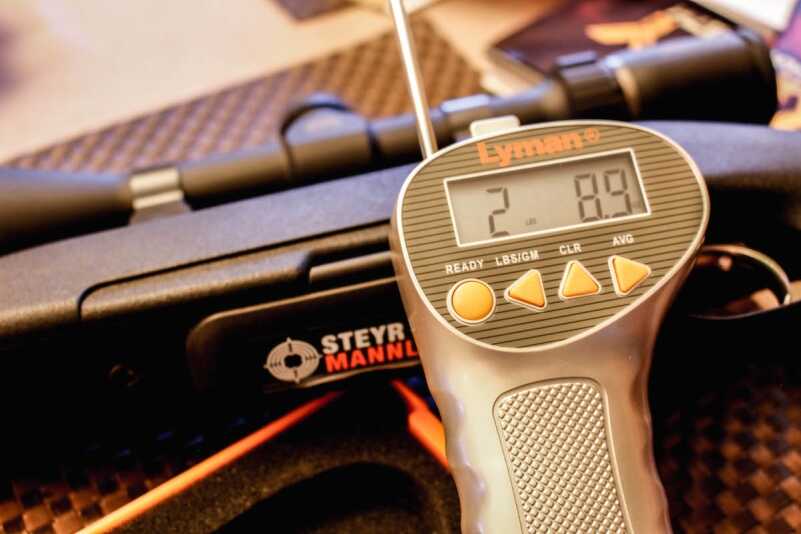
The Lyman digital trigger scale showed the Pro Hunter’s trigger broke at an average weight of 2 lbs, 9 oz.
The Browning stuff was both good and bad, with the heavier 185-grain BXC – their controlled expansion bullet – printing groups averaging 1.10 inch. Their lighter 155-grain BXR bullet – designed for rapid expansion on deer-sized game – printed groups a bit wider, with the three-shot spread hanging around 1.6 inch; certainly accurate enough for almost any hunting situation, but certainly not the best the Pro Hunter had to offer.
Lastly, I tested the ABM Hunt Ready Match Classic Hunter, but for reasons I cannot explain, our test gun didn’t like this load. Several three-shot groups gave an average of just under 2.0 inches, and I’ve had other .300s put this ammunition into tiny groups. I believe it’s an example of barrel harmonics rearing its ugly head.
The Drop Zone
I had some six-inch steel plates set out at 200 and 300 yards, and thought it’d be fun to put the Burris Droptine to the test. With a flat-shooting cartridge like the .300 Winchester Magnum, shots out to 200 yards – where the rifle should be zeroed – shouldn’t require any sort of hold over, but 300 yards certainly does. Using the second hash-mark below the main crosshair of the Ballistic Plex reticle, it was nice to see the steel move, time and time again, reassuring me that this rifle would effectively strike the vitals of even a pronghorn antelope at that distance. The adjustable objective of the Burris scope kept things crisp, is spite of the increasing temperatures and correlative heat mirage of the afternoon. For an affordable piece of glass, the Burris Droptine did everything I asked of it. The Talley rings and bases kept it in place, and it took every ounce of recoil in stride.
In Conclusion
There is a trend, which seems to be increasing, moving our common rifles away from blued steel and walnut, and toward weather-proof finishes and synthetic stocks. Whether or not you like this move – I am a tried-and-true fan of the classic configuration, in spite of its issues – these rifles do have a place and fulfill a role in modern hunting. The Steyr Pro Hunter does not have the classic lines of a vintage, early 20th century European rifle. It does not easily cause its owner to boast of its beauty. What it does do is function, and function well. The stock feels better than it looks. The gun stands up to the elements. And, it shoots and shoots well. Carrying an MSRP of $850.00, it gives a hunter a helluva lot of gun for what is a minimal investment in today’s market. You could do a lot worse than having all of those features rolled into one rifle.
For more information, visit https://steyrarms.com/firearms/hunting-rifles/mannlicher-pro-hunter.html.
To purchase on GunsAmerica.com, click this link: https://www.gunsamerica.com/Search.aspx?T=Steyr%20Pro%20Hunter.

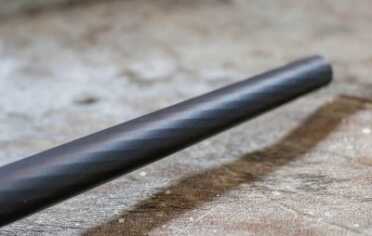
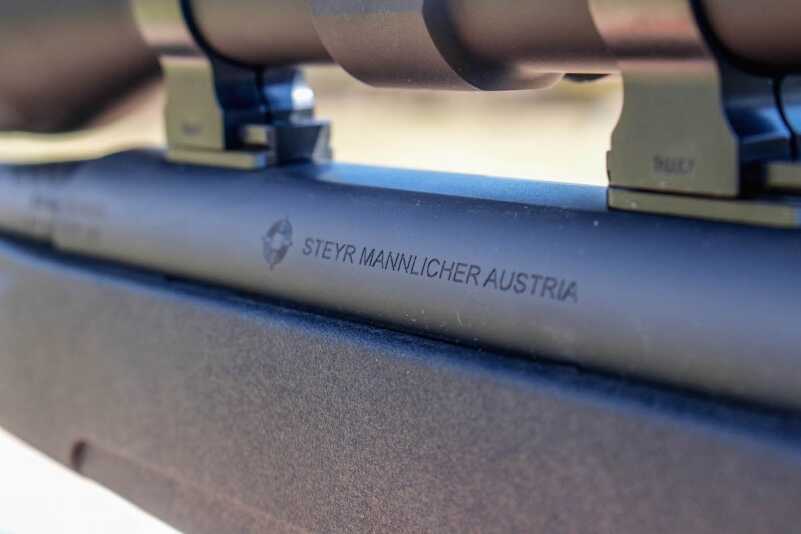
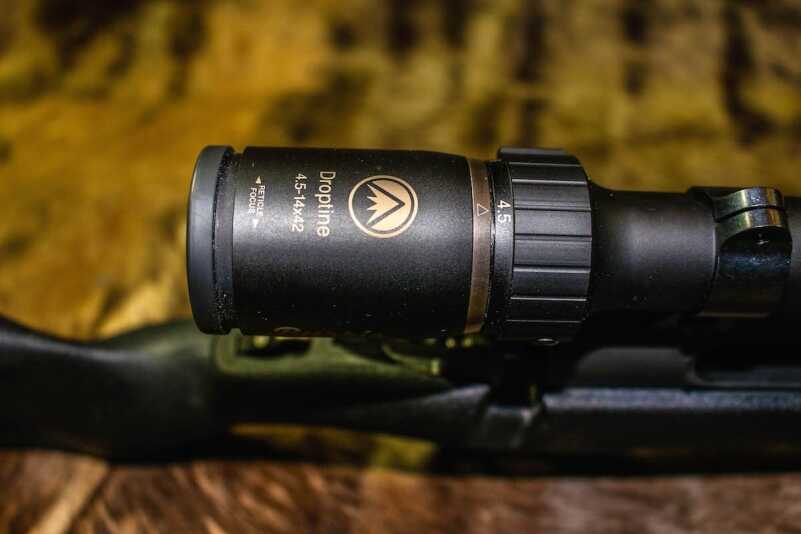

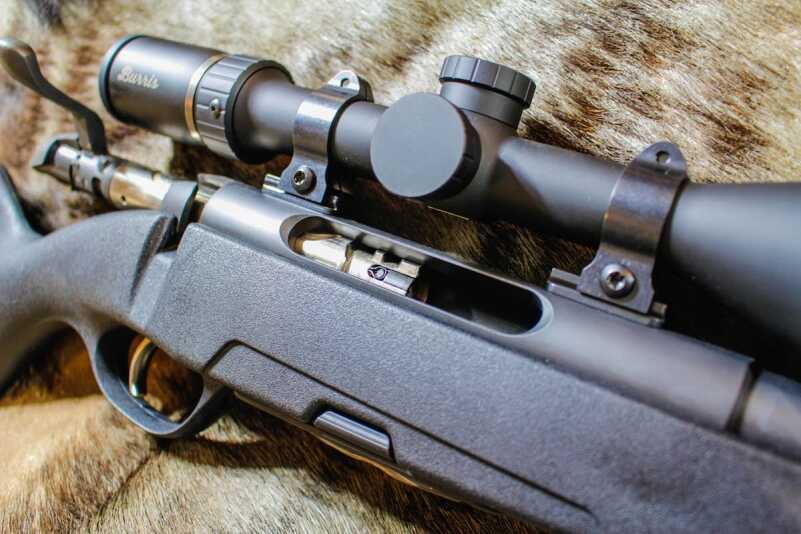
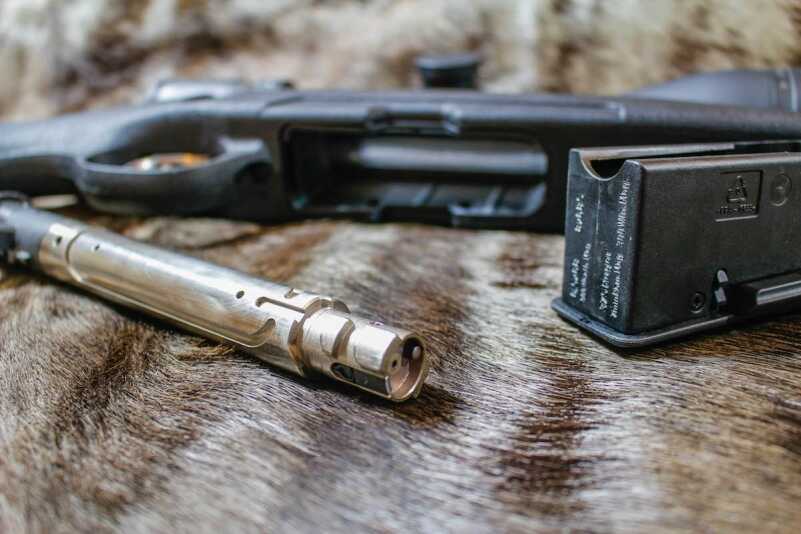
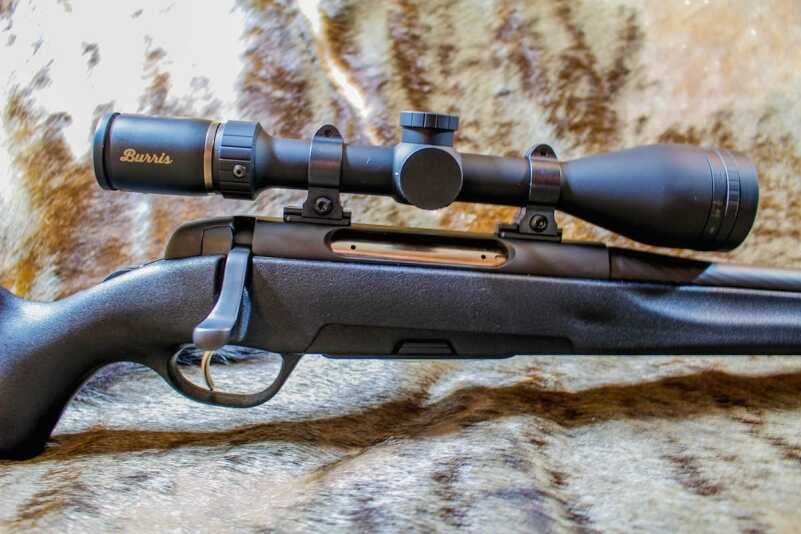
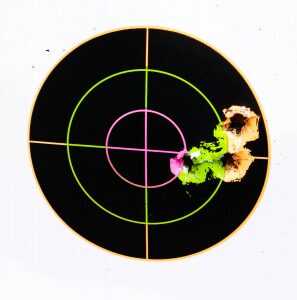
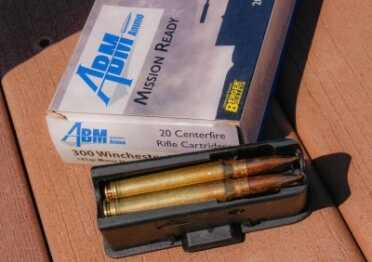
I purchased a prohunter on closeout. Dont like look of stock and overall is heavy. Hopefully a good choice on the 30-06 but will see. Concerned may not be supported for parts? Also looking into a nice wood stock. Anyone know where to locate one?
I’ve had my 30-06 for years. Under a minute of angle all day. Well made, beautiful trigger, perfect weight, indestructible stock, smooth smooth bolt, elegant looking and easily worth the price tag. I have many old school Vintage Mauser rifles, so I am used to this whole world German technology. This rifle is amazing
I bought mine in 1996. A 25-06. I didn’t like the way it shot so I sent back to Styer. They got it back to me about 2 weeks later with a test target, 100 meters. 125 grain Remington Core Locs, 5/8 inch 3 shot group. Yeah, right!! So I bought a box and went to the range. 5/8 inch all day long, every day off a bag. My hand loads are even better.
Interesting to note that the twist-rate is note stated anywhere – unless I missed it?
Todd.
Is it available with set triggers ?
Yes, set triggers are an option. Pricey, but doable. BUT- the factory trigger is the bomb, without touching the adjustment screw.
Looks and review make me think it would be a great hunting rifle, especially for incliment weather, rains and humidity here in Fla. and many other places, with well protected metalwork and synthetic stock that won’t shift zero. A buddy has one of these Pro Hunters, in .30/06, that is about 15 years old, and loves it. Tough as nails, and fantastic accuracy. It’s ‘street price’ is comparable to Rem. 700’s and Tikka T-3’s…. more choices…
I have read many reviews on these rifles, and they are supposed to be great performers. The most commonly mentioned issue that I have seen is that the included synthetic stocks are flimsy at the fore end. Can you comment?
The older models had a fairly soft forend. That has been attended to for the last couple of years. Like a lot of reviews you read on the internet, this is an old complaint. Not of late.
This rifle has visual appeal and is priced in a range that should attract lots of interest. The Barrel is very attractive and being cold hammer forged is a plus as far as I am concerned.
I don’t see the weight in the specs and went to the Steyrs’ website and the weight is also missing?
I own a couple of modern Steyr’s, the SSG variety. They are awesome! Fantastic quality, jaw-droppingly accurate– consistently so, and built so’s that they last and last and without you needing to handle them like some museum piece. For how well known and regarded Steyr rifles and barrels are around the world, it’s strange that I don’t hear as much about them as I do a number of others here in these United States, (Maybe the cost?).
I had a PSG II. Other than BRM in basic training, I am not a trained marksman. Yet I was able to shoot under 1/2 minute of angle with that rifle when firing in the prone supported position. (FYI, mine had the double set triggers.)